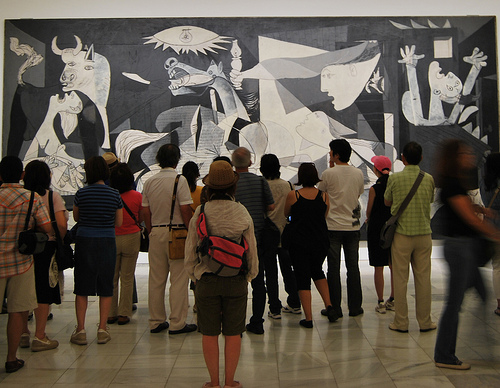Guernica - The Politics of Propaganda

By Carolyn Yeager and Wilhelm Mann
Why Guernica? Above, museum-goers in Spain view the most famous anti-war painting in the world: Guernica by Spanish-born Pablo Picasso. But does what actually happened to this small town justify its becoming a world-wide symbol for “terror bombing”? Or is it another instance of leftist international manipulation?
When we look more closely at the record of the events, we find that manipulation is indeed what happened—the story of Guernica became a propaganda tool of the Communists with the aid of a world-class artist like Picasso. If it were truly about terrorizing a population, Picasso should have created a Dresden, Hamburg, or Hiroshima masterpiece instead.
The Spanish Republican (Red) government commissioned Picasso to create a large mural they could display at international expositions in 1937. They also put the painting on a world tour, which brought their version of the war to world attention. A copy of the painting in tapestry form, commissioned by Nelson Rockefeller in 1955, hangs in the United Nations entrance to the Security Council room.
The bombing raid carried out by the German Legion Condor on April 26, 1937, as allied support for Franco’s Nationalist forces, was not a planned terror act or “test”, yet that idea continues to be repeated today.
From an article based on interviews of participants and surviving documents of the Luftwaffe—specifically an unpublished history of the Legion Condor from the year1940—by Alfred de Zayas1, published in the Journal of the Bundeswehr in 1974, we learn the following:
-
Guernica was on the front line and not an open city. It was heavily defended by six battalions of Basques and Santanders. An armament factory was inside the city and other Red Army facilities were in the immediate vicinity.
-
An air attack at the bridge and road crossing east of Guernica was ordered. All Condor orders were strict that cities must be spared, and especially churches. (Knowing this, the “Rojas” (Reds) stored ammunition in churches, blowing them up when they couldn’t get it out). Only in special cases were military targets in cities permitted to be attacked.
-
Nine aircraft dropped a total of 7950 kg of bombs, but no hits at the bridge were observed because visibility was very poor. The reason for the poor visibility was fire and smoke from the blasting and setting on fire by the Reds, and possibly the international brigades, ahead of the air attack. The relatively primitive targeting devices used at that time were also responsible for non-military objects being hit.
Because the city was wrapped in fire and smoke, the enemy press was able to blame specifically the German squadron for the destruction of Guernica.
The erroneous story that Hermann Goering admitted that Guernica was a “testing ground” for the effects of terror bombing was traced by de Zayas to a Chinese Central News Agency in Taiwan (C.N.A.), whose New York office denied issuing any such report. Other original reports said the city was destroyed by arson, not by air attacks.2
What Goering did say at the IMT in Nuremberg in 1946 is that transport, bomber and fighter planes were sent to Spain (no mention of Guernica) to test material under warlike conditions. De Zayas lists several otherwise reliable authors that have repeated the terror lie in their histories.3
Deaths were also greatly exaggerated. Originally claiming over one thousand, it’s now accepted there were only around 200 civilian deaths - not a large number compared to WWII death tolls. The Condor orders can be seen at the military archives at Freiberg.
Endnotes:
-
“Guernica im Lichte neuerer Untersuchungen” (Guernica in Light of Latest Research), by Alfred Maurice de Zayas, Wehrforschung (WF), June 1974. De Zayas is a distinguished author, researcher and expert on international human rights.
-
The anti-Franco monarchist Antonio Ansaldo wrote in his memoirs that shortly after the attack he was in Guernica and believed at that time the city was destroyed by arson. Later he read about Goering's alleged confession in a French newspaper story and changed his belief.
-
Hugh Thomas, The Spanish Civil War; John Killen, History of the Luftwaffe; Vincente Talon, Arde Guernica: Pedro de Basaldus, En defensa de la liberdad; and Alberto de Onainda, Hombre de Paz en la Guerra
Category
World War II- 15708 reads









